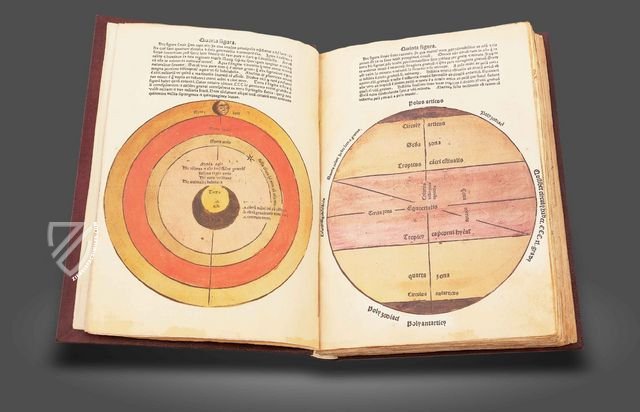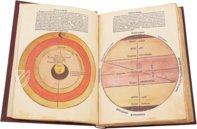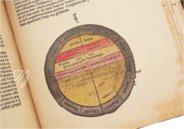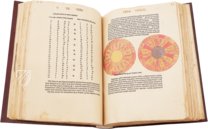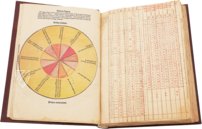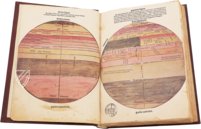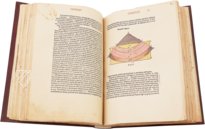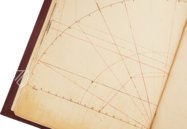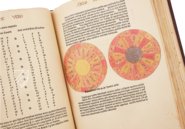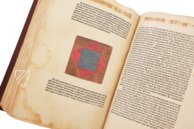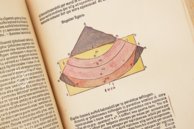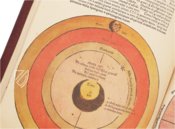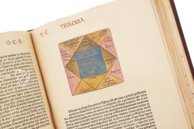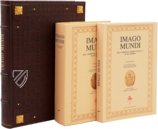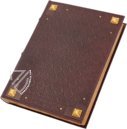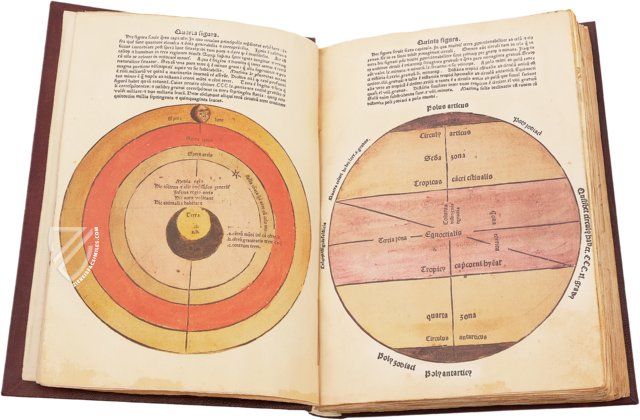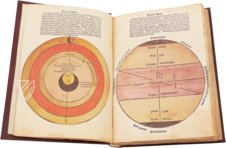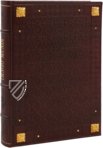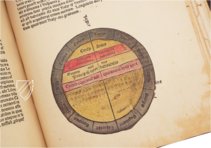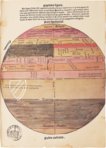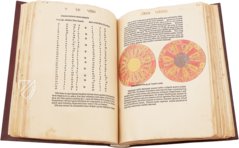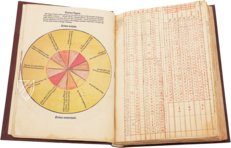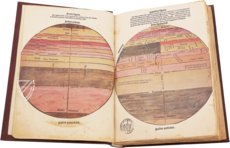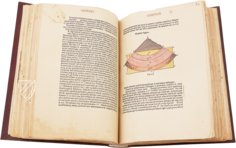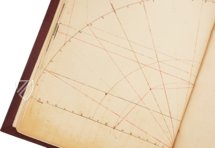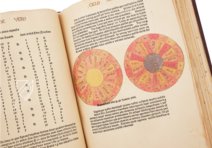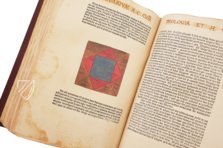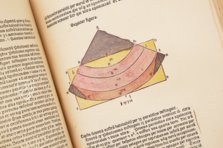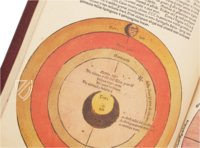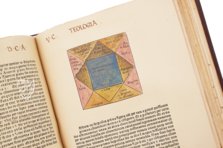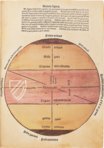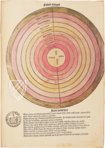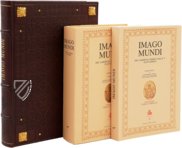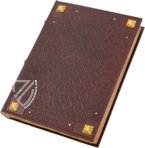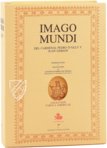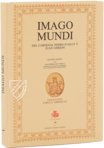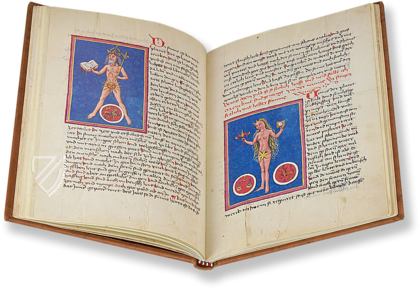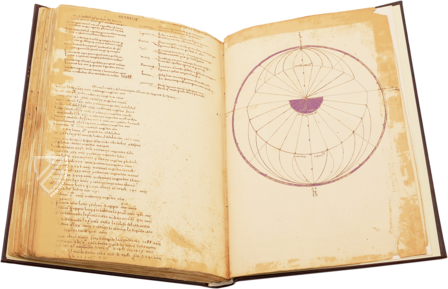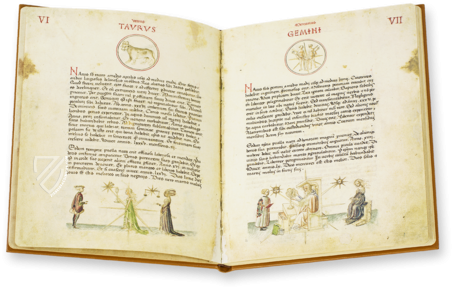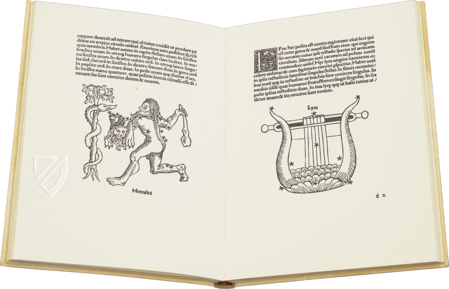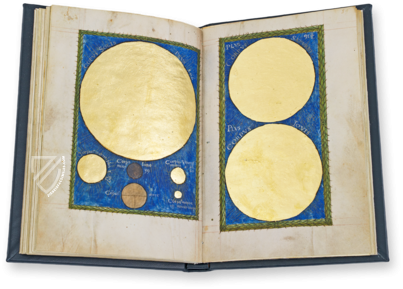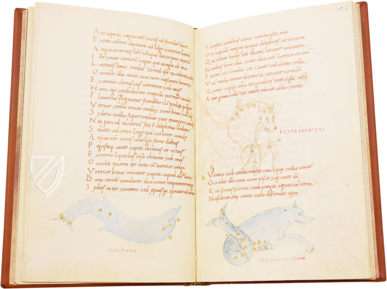Columbus's Imago Mundi
(1,000€ - 3,000€)
Christopher Columbus trusted in this text more than all the other suggestions of his contemporaries: the astronomical-geographical text Imago Mundi by Pierre d’Ailly. The most famous work by this significant French theologian from the year 1410 had not been at the cutting edge in Columbus’ day for a long time. The false calculations by the explorer were a result, as was the discovery of a new continent. Nevertheless, Pierre d'Ailly's Imago mundi is a wonderful and impressive testimony to the cosmographic knowledge of the early 15th century, especially since this copy of the edition printed in the early 1480s by John of Paderborn in Leuven is truly unique due to numerous personal notes by the famous discoverer. The Latin text is also accompanied by a great number of large diagrams and illustrative drawings, all colored in a beautiful palette of red, yellow and orange pigments, which are another fascinating feature of this remarkable incunabulum.
Columbus's Imago Mundi
Christopher Columbus trusted in this text more than all the other suggestions of his contemporaries: the astronomical-geographical text Imago Mundi by Pierre d’Ailly. The most famous work by this significant French theologian from the year 1410 had not been at the cutting edge in Columbus’ day for a long time. The false calculations by the explorer were a result, as was the discovery of a new continent. Pierre d’Ailly’s Imago Mundi is nonetheless a wonderful and impressive testimonial to the cosmographic knowledge of the early 15th century, and the personal copy of Christopher Columbus with his notes is truly unique!
Columbus’ Gorgeous Edition
The edition of the Imago Mundi text from the Biblioteca Capitular y Colombina in Seville was printed ca. 1483 in Leuven in modern Belgium. The printer was Johann von Paderborn, one of the first printers in Leuven and in Flanders as a whole. Pierre d’Ailly’s magnum opus is recorded on 288 pages measuring 28 x 21 cm. Subdivided into 18 chapters or tractates, each illustrated with gorgeous and informative drawings, it offers a terrific overview of the astrological-geographical wisdom of the early 15th century.
A Witness to Historical Events
The author of this work was Pierre d’Ailly (1350/1–1420), a significant French theologian and cardinal. D’Ailly, inter alia, participated in the disputes of the Western Schism, the Council of Constance, and the inquisition of the reformer Jan Hus. As a result, he was a witness to the most significant historic events of his time. Additionally, he composed numerous works of a mystic nature and displayed his deep interest in astrology. His most famous work is nevertheless the astronomical-geographical text Imago Mundi from 1410. This is compiled from various sources from Antiquity and the Middle Ages and contains tractates on the ordering of the cosmos and the Earth along with a description of the three continents that were known at that time.
The Idea of the Indian Expedition
The fact that this was the personal copy of Christopher Columbus is of even greater historical significance. The important explorer furnished the book with notes from his own hand, in addition to some comments left in the book by his son Hernando. The numerous comments suggest just how intensely the explorer grappled with the text of the Imago Mundi. The text had a measurable influence on the journeys of exploration and gave Columbus – as is indicated in the research – his initial idea for an expedition to India. Nonetheless, Columbus relied more on the already 80 year old and outdated information of D’Ailly than on contemporary references, to his detriment, and drifted off course as a result. Yet, this led to one of the most important events in world history: the discovery of the Americas!
Codicology
- Alternative Titles
- Pierre d'Ailly's "Imago Mundi"
- Size / Format
- 288 pages / 28.0 × 21.0 cm
- Origin
- Belgium
- Date
- Between 1480 and 1483
- Epochs
- Style
- Language
- Illustrations
- Various colored charts and drawings
- Content
- Astronomical-geographical text by Pierre d’Ailly owned by Christopher Columbus
- Artist / School
- Pierre d´Ailly (1351–1420) (author)
Annotations by Christopher Columbus and his son Ferdinand - Previous Owners
- Christopher Columbus (1451–1506)
Ferdinand Columbus (1488–1539)
Columbus's Imago Mundi
Orbits of the Celestial Bodies
In harmonious shades of pink and yellow, this diagram shows the orbits of various celestial bodies - including planets as well as the sun and moon - around the earth in the center and is thus a wonderful representation of the geocentrism of the Middle Ages. For example, the accompanying text describes how the sun spends 30 days and 10 hours in each sign of the zodiac during its year-long orbit around the earth.
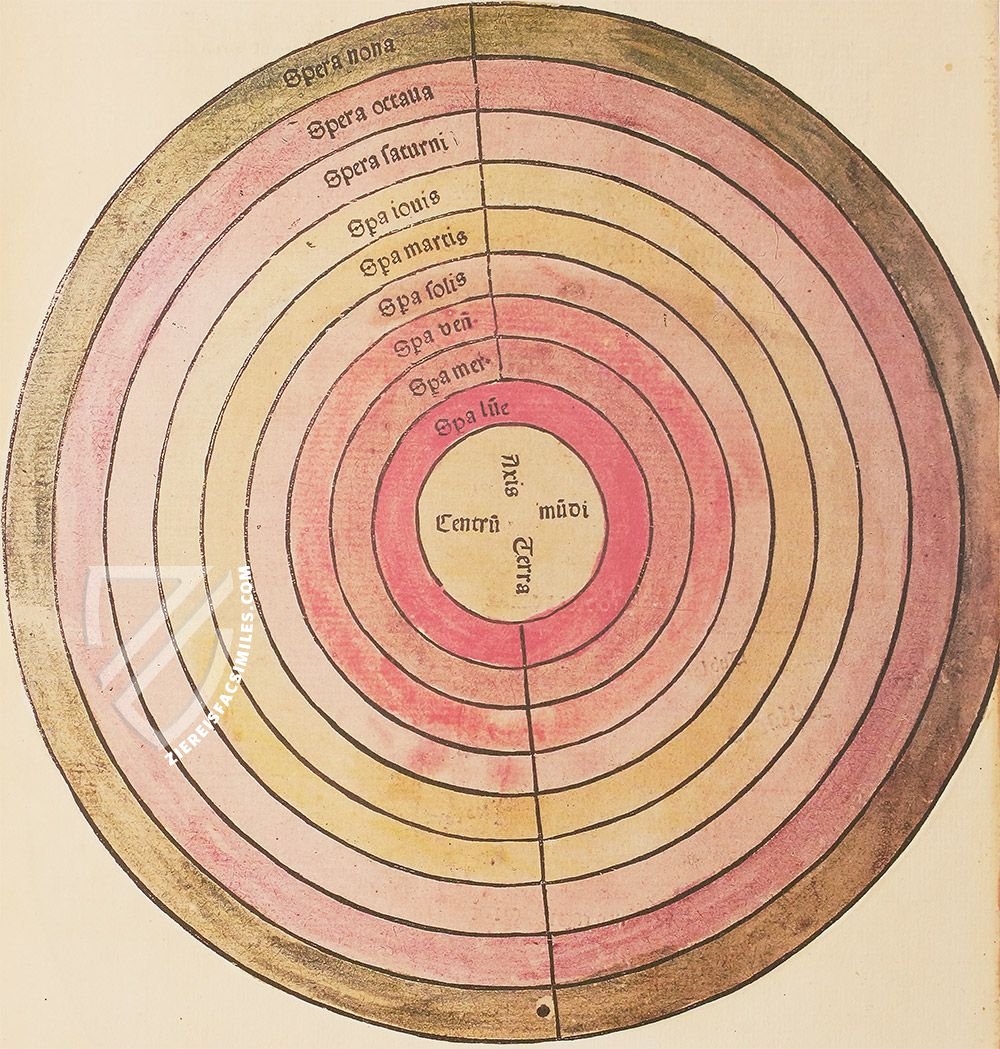
Columbus's Imago Mundi
Division of the world
This schematic representation of the world shows the division into Europe, Asia and Africa that was common in the Middle Ages. All three continents are located in the upper half of the circle, which is divided into many smaller rectangles, mostly denoting regions. The empty space below the equator visualizes the great unknown that many areas of the earth still represented for 15th century Europeans.
In the upper left quarter, in addition to the inscriptions, three special features stand out, which were probably intended to serve as geographical markers: On the left edge, an expanse of water is depicted next to the word "Oceanus" and below it the Atlas Mountains in the form of three bright yellow 'hills'. Further to the right, the Nile can also be seen making its way through Africa from the dark-colored areas of Europe. An inscription on the Asian part, which identifies a region as the "habitat of elephants", which already aroused great fascination in the Middle Ages, also makes us smile today.
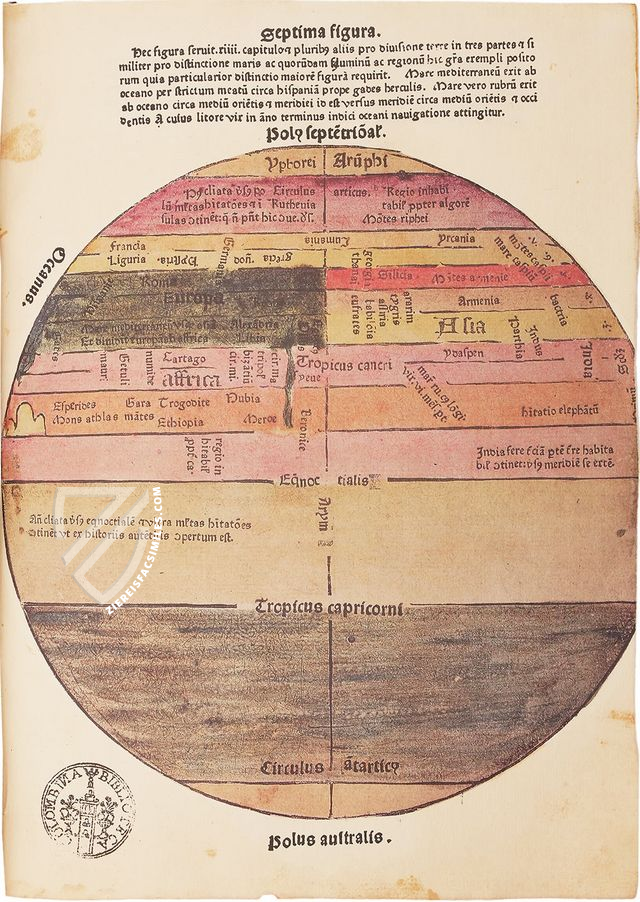
#1 Imago Mundi
Language: Spanish
(1,000€ - 3,000€)
- Treatises / Secular Books
- Apocalypses / Beatus
- Astronomy / Astrology
- Bestiaries
- Bibles / Gospels
- Chronicles / History / Law
- Geography / Maps
- Saints' Lives
- Islam / Oriental
- Judaism / Hebrew
- Single Leaf Collections
- Leonardo da Vinci
- Literature / Poetry
- Liturgical Manuscripts
- Medicine / Botany / Alchemy
- Music
- Mythology / Prophecies
- Psalters
- Other Religious Books
- Games / Hunting
- Private Devotion Books
- Other Genres
- Afghanistan
- Armenia
- Austria
- Belgium
- Belize
- Bosnia and Herzegovina
- China
- Colombia
- Costa Rica
- Croatia
- Cyprus
- Czech Republic
- Denmark
- Egypt
- El Salvador
- Ethiopia
- France
- Germany
- Greece
- Guatemala
- Honduras
- Hungary
- India
- Iran
- Iraq
- Israel
- Italy
- Japan
- Jordan
- Kazakhstan
- Kyrgyzstan
- Lebanon
- Liechtenstein
- Luxembourg
- Mexico
- Morocco
- Netherlands
- Palestine
- Panama
- Peru
- Poland
- Portugal
- Romania
- Russia
- Serbia
- Spain
- Sri Lanka
- Sweden
- Switzerland
- Syria
- Tajikistan
- Turkey
- Turkmenistan
- Ukraine
- United Kingdom
- United States
- Uzbekistan
- Vatican City
- A. Oosthoek, van Holkema & Warendorf
- Aboca Museum
- Ajuntament de Valencia
- Akademie Verlag
- Akademische Druck- u. Verlagsanstalt (ADEVA)
- Aldo Ausilio Editore - Bottega d’Erasmo
- Alecto Historical Editions
- Alkuin Verlag
- Almqvist & Wiksell
- Amilcare Pizzi
- Andreas & Andreas Verlagsbuchhandlung
- Archa 90
- Archiv Verlag
- Archivi Edizioni
- Arnold Verlag
- ARS
- Ars Magna
- ArtCodex
- AyN Ediciones
- Azimuth Editions
- Badenia Verlag
- Bärenreiter-Verlag
- Belser Verlag
- Belser Verlag / WK Wertkontor
- Benziger Verlag
- Bernardinum Wydawnictwo
- BiblioGemma
- Biblioteca Apostolica Vaticana (Vaticanstadt, Vaticanstadt)
- Bibliotheca Palatina Faksimile Verlag
- Bibliotheca Rara
- Boydell & Brewer
- Bramante Edizioni
- Bredius Genootschap
- Brepols Publishers
- British Library
- C. Weckesser
- Caixa Catalunya
- Canesi
- CAPSA, Ars Scriptoria
- Caratzas Brothers, Publishers
- Carus Verlag
- Casamassima Libri
- Centrum Cartographie Verlag GmbH
- Chavane Verlag
- Christian Brandstätter Verlag
- Circulo Cientifico
- Club Bibliófilo Versol
- Club du Livre
- CM Editores
- Collegium Graphicum
- Collezione Apocrifa Da Vinci
- Comissão Nacional para as Comemorações dos Descobrimentos Portugueses
- Coron Verlag
- Corvina
- CTHS
- D. S. Brewer
- Damon
- De Agostini/UTET
- De Nederlandsche Boekhandel
- De Schutter
- Deuschle & Stemmle
- Deutscher Verlag für Kunstwissenschaft
- DIAMM
- Droz
- E. Schreiber Graphische Kunstanstalten
- Ediciones Boreal
- Ediciones Grial
- Ediclube
- Edições Inapa
- Edilan
- Editalia
- Edition Deuschle
- Edition Georg Popp
- Edition Leipzig
- Edition Libri Illustri
- Editiones Reales Sitios S. L.
- Éditions de l'Oiseau Lyre
- Editions Medicina Rara
- Editorial Casariego
- Editorial Mintzoa
- Editrice Antenore
- Editrice Velar
- Edizioni Edison
- Egeria, S.L.
- Eikon Editores
- Electa
- Emery Walker Limited
- Enciclopèdia Catalana
- Eos-Verlag
- Ephesus Publishing
- Ernst Battenberg
- Eugrammia Press
- Extraordinary Editions
- Fackelverlag
- Facsimila Art & Edition
- Facsimile Editions Ltd.
- Facsimilia Art & Edition Ebert KG
- Faksimile Verlag
- Feuermann Verlag
- Folger Shakespeare Library
- Franco Cosimo Panini Editore
- Friedrich Wittig Verlag
- Fundación Hullera Vasco-Leonesa
- G. Braziller
- Gabriele Mazzotta Editore
- Gebr. Mann Verlag
- Gesellschaft für graphische Industrie
- Getty Research Institute
- Giovanni Domenico de Rossi
- Giunti Editore
- Graffiti
- Grafica European Center of Fine Arts
- Guido Pressler
- Guillermo Blazquez
- Gustav Kiepenheuer
- H. N. Abrams
- Harrassowitz
- Harvard University Press
- Helikon
- Hendrickson Publishers
- Henning Oppermann
- Herder Verlag
- Hes & De Graaf Publishers
- Hoepli
- Holbein-Verlag
- Houghton Library
- Hugo Schmidt Verlag
- Idion Verlag
- Il Bulino, edizioni d'arte
- ILte
- Imago
- Insel Verlag
- Insel-Verlag Anton Kippenberger
- Instituto de Estudios Altoaragoneses
- Instituto Nacional de Antropología e Historia
- Istituto dell'Enciclopedia Italiana - Treccani
- Istituto Ellenico di Studi Bizantini e Postbizantini
- Istituto Geografico De Agostini
- Istituto Poligrafico e Zecca dello Stato
- Italarte Art Establishments
- Jan Thorbecke Verlag
- Johnson Reprint Corporation
- Josef Stocker
- Josef Stocker-Schmid
- Jugoslavija
- Karl W. Hiersemann
- Kasper Straube
- Kaydeda Ediciones
- Kindler Verlag / Coron Verlag
- Kodansha International Ltd.
- Konrad Kölbl Verlag
- Kurt Wolff Verlag
- La Liberia dello Stato
- La Linea Editrice
- La Meta Editore
- Lambert Schneider
- Landeskreditbank Baden-Württemberg
- Leo S. Olschki
- Les Incunables
- Liber Artis
- Library of Congress
- Libreria Musicale Italiana
- Lichtdruck
- Lito Immagine Editore
- Lumen Artis
- Lund Humphries
- M. Moleiro Editor
- Maison des Sciences de l'homme et de la société de Poitiers
- Manuscriptum
- Martinus Nijhoff
- Maruzen-Yushodo Co. Ltd.
- MASA
- Massada Publishers
- McGraw-Hill
- Metropolitan Museum of Art
- Militos
- Millennium Liber
- Müller & Schindler
- Nahar - Stavit
- Nahar and Steimatzky
- National Library of Wales
- Neri Pozza
- Nova Charta
- Oceanum Verlag
- Odeon
- Orbis Mediaevalis
- Orbis Pictus
- Österreichische Staatsdruckerei
- Oxford University Press
- Pageant Books
- Parzellers Buchverlag
- Patrimonio Ediciones
- Pattloch Verlag
- PIAF
- Pieper Verlag
- Plon-Nourrit et cie
- Poligrafiche Bolis
- Presses Universitaires de Strasbourg
- Prestel Verlag
- Princeton University Press
- Prisma Verlag
- Priuli & Verlucca, editori
- Pro Sport Verlag
- Propyläen Verlag
- Pytheas Books
- Quaternio Verlag Luzern
- Reales Sitios
- Recht-Verlag
- Reichert Verlag
- Reichsdruckerei
- Reprint Verlag
- Riehn & Reusch
- Roberto Vattori Editore
- Rosenkilde and Bagger
- Roxburghe Club
- Salerno Editrice
- Saltellus Press
- Sandoz
- Sarajevo Svjetlost
- Schöck ArtPrint Kft.
- Schulsinger Brothers
- Scolar Press
- Scrinium
- Scripta Maneant
- Scriptorium
- Shazar
- Siloé, arte y bibliofilia
- SISMEL - Edizioni del Galluzzo
- Sociedad Mexicana de Antropología
- Société des Bibliophiles & Iconophiles de Belgique
- Soncin Publishing
- Sorli Ediciones
- Stainer and Bell
- Studer
- Styria Verlag
- Sumptibus Pragopress
- Szegedi Tudomànyegyetem
- Taberna Libraria
- Tarshish Books
- Taschen
- Tempus Libri
- Testimonio Compañía Editorial
- Thames and Hudson
- The Clear Vue Publishing Partnership Limited
- The Facsimile Codex
- The Folio Society
- The Marquess of Normanby
- The Richard III and Yorkist History Trust
- Tip.Le.Co
- TouchArt
- TREC Publishing House
- TRI Publishing Co.
- Trident Editore
- Tuliba Collection
- Typis Regiae Officinae Polygraphicae
- Union Verlag Berlin
- Universidad de Granada
- University of California Press
- University of Chicago Press
- Urs Graf
- Vallecchi
- Van Wijnen
- VCH, Acta Humaniora
- VDI Verlag
- VEB Deutscher Verlag für Musik
- Verlag Anton Pustet / Andreas Verlag
- Verlag Bibliophile Drucke Josef Stocker
- Verlag der Münchner Drucke
- Verlag für Regionalgeschichte
- Verlag Styria
- Vicent Garcia Editores
- W. Turnowski Ltd.
- W. Turnowsky
- Waanders Printers
- Wiener Mechitharisten-Congregation (Wien, Österreich)
- Wissenschaftliche Buchgesellschaft
- Wissenschaftliche Verlagsgesellschaft
- Wydawnictwo Dolnoslaskie
- Xuntanza Editorial
- Zakład Narodowy
- Zollikofer AG

